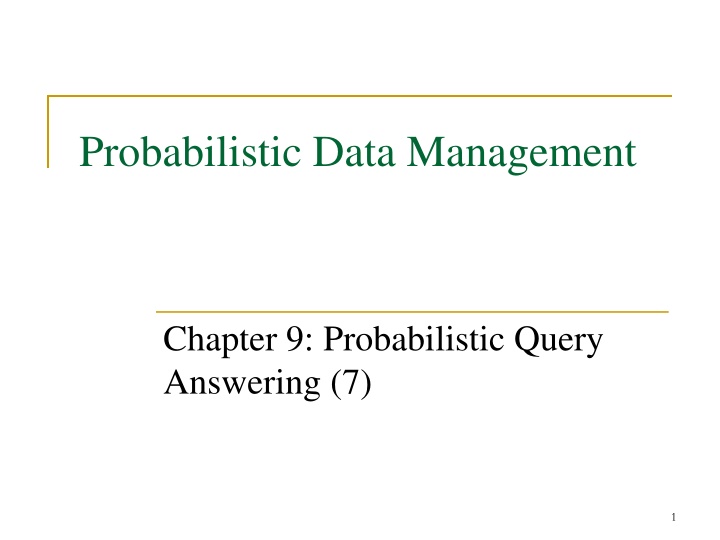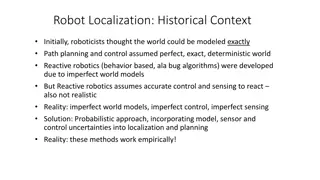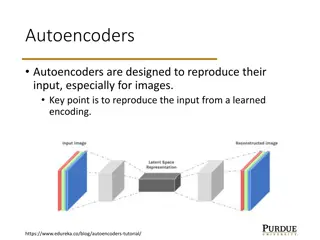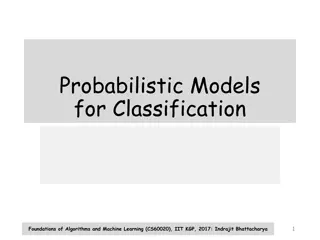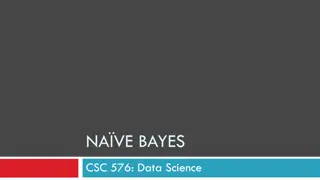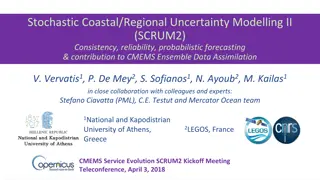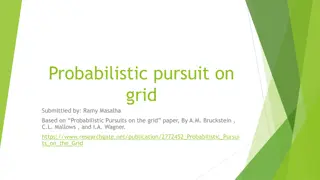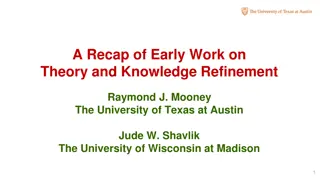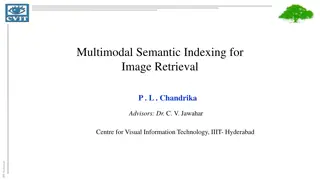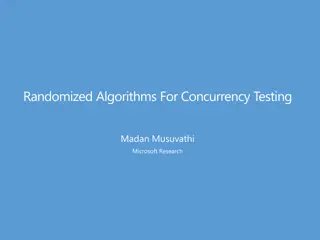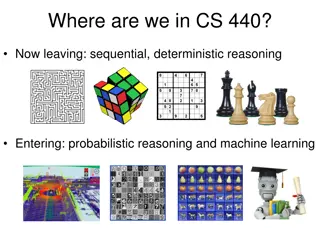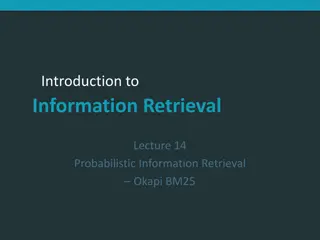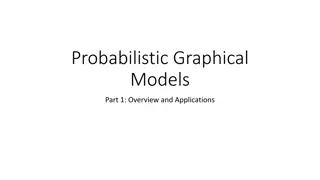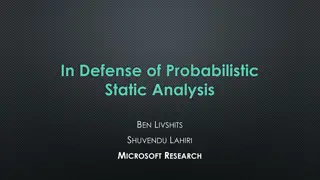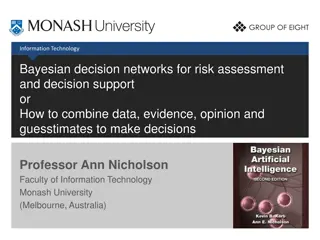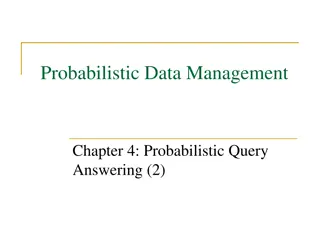Probabilistic Data Management
In this chapter, explore various types of probabilistic queries, focusing on correlations in uncertain data and sensor networks. Learn about representing and querying correlated tuples in probabilistic databases through examples and graphical models.
Download Presentation

Please find below an Image/Link to download the presentation.
The content on the website is provided AS IS for your information and personal use only. It may not be sold, licensed, or shared on other websites without obtaining consent from the author.If you encounter any issues during the download, it is possible that the publisher has removed the file from their server.
You are allowed to download the files provided on this website for personal or commercial use, subject to the condition that they are used lawfully. All files are the property of their respective owners.
The content on the website is provided AS IS for your information and personal use only. It may not be sold, licensed, or shared on other websites without obtaining consent from the author.
E N D
Presentation Transcript
Probabilistic Data Management Chapter 9: Probabilistic Query Answering (7) 1
Objectives In this chapter, you will: Explore the definitions of more probabilistic query types PNN on locally correlated data 2
Introduction In real-world applications, data are often uncertain and imprecise Correlations are often contained in these data Sensor networks Spatially close sensors often report correlated data within the same period of time Relational/probabilistic databases Functional dependencies, A B Data integration Intermediate join results: (R JOINp1S) JOINp2 (R JOINp3T) 3
Representing and Querying Correlated Tuples in Probabilistic Databases P. Sen and A. Deshpande, International Conference on Data Engineering (ICDE), 2007 4
Example of Tuple Correlation probabilistic database (tuple independence) possible worlds query evaluation P. Sen and A. Deshpande. Representing and Querying Correlated Tuples in Probabilistic Databases. In ICDE, 2007 5
Example of Tuple Correlation (cont'd) Tuple Correlations Independent s1, s2, t1 are independent of each other Implies Presence of t1 implies absence of s1 and s2 Mutually exclusive Presence of t1 implies absence of s1 Presence of s1 implies absence of t1 nxor Presence (absence) of t1 almost certainly implies presence (absence) of s1 probabilistic database (tuple correlations) P. Sen and A. Deshpande. Representing and Querying Correlated Tuples in Probabilistic Databases. In ICDE, 2007 6
Example of Tuple Correlation (cont'd) probabilistic database (tuple correlations) P. Sen and A. Deshpande. Representing and Querying Correlated Tuples in Probabilistic Databases. In ICDE, 2007 7
Probabilistic Graphical Model Factored representation P. Sen and A. Deshpande. Representing and Querying Correlated Tuples in Probabilistic Databases. In ICDE, 2007 8
Probabilistic Graphical Model (cont'd) probabilistic database Implies: Presence of t1 implies absence of s1 and s2 P. Sen and A. Deshpande. Representing and Querying Correlated Tuples in Probabilistic Databases. In ICDE, 2007 9
Indexing Correlated Probabilistic Databases B. Kanagal and A. Deshpande, International Conference on Management of data (SIGMOD), 2009 10
Junction Tree Algorithm (Hugin Algorithm) For probabilistic graphical model If the graph is a directed acyclic graph, then moralize it by connecting nodes that have a common child, and then making all edges in the graph undirected File:Chordal-graph.svg Triangulate the graph to make it chordal Construct a junction tree from the triangulated graph Message passing Steiner tree 11
Indexing Correlated Uncertain Data probabilistic graphical model probabilistic database junction tree INDSEP index B. Kanagal and A. Deshpande. Indexing Correlated Probabilistic Databases. In SIGMOD, 2009. 12
Indexing Correlated Uncertain Data (cont'd) Partition the junction tree into groups Each group corresponds to one leaf node Pre-compute joint probabilities within nodes, and shortcut potentials among nodes Recursively group tree nodes, and build a tree structure B. Kanagal and A. Deshpande. Indexing Correlated Probabilistic Databases. In SIGMOD, 2009. 13
Efficient Query Evaluation over Temporally Correlated Probabilistic Streams B. Kanagal and A. Deshpande, International Conference on Data Engineering (ICDE), 2009 14
Temporally Correlated Probabilistic Data Probabilistic data in a streaming fashion have many real applications Sensor network RFID Probabilistic data streams often exhibit temporal correlations B. Kanagal and A. Deshpande. Efficient Query Evaluation over Temporally Correlated Probabilistic Streams. In ICDE, 2009. 15
Markovian Stream Model A Markovian Stream Data at each timestamp correspond to a random variable Data at two consecutive timestamps are correlated Data that are not at two consecutive timestamps are conditionally independent No deletion p(X1), marginal distribution p(X3 | X2), conditional probability table a markovian stream B. Kanagal and A. Deshpande. Efficient Query Evaluation over Temporally Correlated Probabilistic Streams. In ICDE, 2009. 16
Markovian Stream Model (cont'd) Two Markovian Streams stream 1 stream 2 B. Kanagal and A. Deshpande. Efficient Query Evaluation over Temporally Correlated Probabilistic Streams. In ICDE, 2009. 17
Markov Sequences Schema graph Graphical representation of the two step joint distribution that repeats continuously Clique list The set of direct dependencies present between successive sets of random variables schema graph clique list 18
A Generic Framework for Handling Uncertain Data with Local Correlations Very Large Data Bases (VLDB), 2011 19
Motivation Example Sensory data: <temperature, light> Forest monitoring application forest n2 n1 n5 n4 n6 n3 n8 n7 sensor node 20
Motivation Example (cont'd) Samples si collected from sensor node ni light s4 s6 s3 s5 s7 s1 s8 s2 temperature O 21
Motivation Example (cont'd) Sensory data are uncertain and imprecise light uncertainty regions o4 o6 o3 o5 o7 o1 o8 o2 temperature O 22
Motivation Example (cont'd) 3 monitoring areas forest Area 1 n2 Area 2 n5 n1 n4 n6 Area 3 n3 n8 n7 sensor node monitoring area 23
Motivation Example (cont'd) 3 monitoring areas forest Area 1 n2 Area 2 n5 n1 n4 n6 Area 3 n3 sensors far away spatially close sensors n8 n7 sensor node monitoring area 24
Locally Correlated Sensory Data light uncertainty regions local correlations among sensory data Area 2 o4 o6 o3 o5 o7 o1 o8 Area 3 Area 1 o2 temperature O 25
Nearest Neighbor Queries on Locally Correlated Uncertain Data light query point q o4 o6 o3 o5 o7 o1 o8 o2 temperature O 26
Outline Introduction Model for Locally Correlated Uncertain Data Problem Definition Query Answering on Uncertain Data With Local Correlations Experimental Evaluation Conclusions 27
Introduction Uncertain data are pervasive in real applications Sensor networks RFID networks Location-based services Data integration While existing works often assume the independence among uncertain objects, local correlations! Uncertain objects exhibit correlations 28
Data Model for Local Correlations Data Model Each uncertain object contains several locally correlated partitions (LCPs) Uncertain objects within each LCP are correlated with each other Uncertain objects from distinct LCPs are independent of each other light uncertainty regions local correlations among sensory data o4 o6 o3 o5 o7 o1 o8 o2 temperature O 29
Data Model for Local Correlations (cont'd) Bayesian network Each vertex corresponds to a random variable Each vertex is associated with a conditional probability table (CPT) light o6 Pr{ } a locally correlated partition LCS( ) { } o5 o5 o6 o4 Pr{ | } o4o6 { | } Pr o3o6 o4 o6 o3 o3 o5 o5 temperature Pr{ | , } o5 o3 o4 O 30
Data Model for Local Correlations (cont'd) The joint probability of variables Join tuples in CPTs and multiply conditional probabilities Variable elimination oi t . oi l . o6.t o6.l 23 o6 temperature light Pr{ } o6 T Pr{ } 1 0.8 60 ... ... ... o6 o6.t o6.l o3.t 22 o3.l 65 { | } Pr o3o6 0.2 T Pr{ | } o4o6 2 { | } Pr o3o6 60 23 ... ... ... ... ... o4 o3 o6.t o6.l 23 o4.t 23 o4.l 61 Pr{ | } o4o6 0.4 T 3 60 ... ... ... ... ... o5 o3.t o3.l o4.t 23 o4.l 61 Pr{ | , } o5 o5.t o5.l 23 o3 o4 T 4 Pr{ | , } o5 o3 o4 22 65 65 0.5 ... ... ... ... ... ... ... 31
Definition of LC-PNN Query Probabilistic Nearest Neighbor Query on Uncertain and Locally Correlated Data, LC-PNN light query point q o4 o6 o3 o5 o7 o1 o8 o2 temperature O 32
Challenges & Solutions Challenges Straightforward method of linear scan is costly Computation cost of integration is expensive Dealing with data correlations Filtering Methods Index pruning Candidate filtering with pre-computations 33
Index Pruning Basic idea Let best_so_far be the smallest maximum distance from query point q to any uncertain objects seen so far light query point q o4 best_so_far o6 Then, any objects/nodes e having mindist(q, e) > best_so_far can be safely pruned o3 o5 o7 o1 o8 o2 temperature O 34
Candidate Filtering with Pre-Computations Basic idea Obtain an upper bound, UB_PrLC-PNN(q, oi), of the LC-PNN probability Object oi can be safely pruned, if UB_PrLC-PNN(q, oi) < How to obtain the probability upper bound? Derived from formula of the LC-PNN probability upper bound via pivots! 35
Derivation of Probability Upper Bound pivotpivs5 36
Candidate Positions of Pivots samples5 light candidate positions for pivots nw ne se sw q pivot pivs5 query point q O temperature 37
Selection of Pivot Positions We provide a cost model to formalize the filtering and refinement costs, and obtain a good value of parameter to achieve low query cost s5 sample nw ne se sw pivs5 pivot query point q 38
LC-PNN Query Procedure Index uncertain objects containing LCPs in an R-tree based index For an LC-PNN query When traversing the index, apply index pruning method and candidate filtering to remove false alarms Refine candidates and return true query answers 39
Experimental Evaluation Data Sets Real data: California road network Synthetic data: lUeU, lUeG, lSeU, and lSeG Generate center locations of LCPs with Uniform or Skew distribution Produce extent lengths of LCPs with Uniform or Gaussian distribution Within LCPs, randomly generate locally correlated uncertain objects with Bayesian networks Competitor Basic method [Cheng et al., SIGMOD 2003] Assuming uncertain objects are independent Measures Wall clock time Speed-up ratio 40
LC-PNN Performance vs. lUeU speed-up ratio lUeU time lUeG time lUeG speed-up ratio wall clock time (sec) speed-up ratio 10 100 1 10 0.1 1 0.01 0.1 0.1 0.2 0.5 0.8 0.9 0.1 0.2 0.5 0.8 0.9 Extent length of LCP = [1, 3], data size N = 150K, average No. of uncertain objects in an LCP = 5 41
Summary We proposed the problem of queries over locally correlated uncertain data, in particular, the LC-PNN query, which is important in real applications We designed the index pruning method, and based on a proposed cost model, we presented the candidate filtering method via offline pre-computations w.r.t. pivots We provided efficient query processing techniques to answer LC-PNN queries on locally correlated uncertain data We conducted extensive experiments to verify the LC- PNN query efficiency 42
